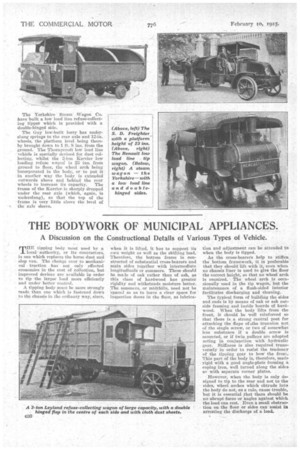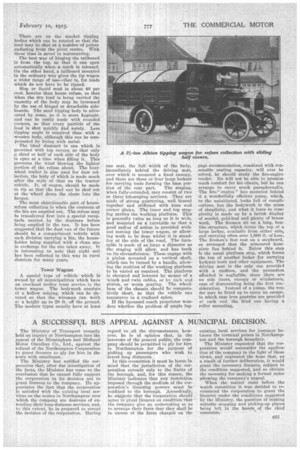THE BODYWORK OF MUNICIPAL APPLIANCES.
Page 14

Page 15

If you've noticed an error in this article please click here to report it so we can fix it.
A Discussion on the Constructional Details of Various Types of Vehicle.
THE tipping body most used by a local authority, or its contractors, is one which replaces the horse dust and slop van. The .change over to mechanical traction ha.s not only effected economies in the cost of collection, but improved devices are available in order to tip the larger load more efficiently and under' bettorcontrol.
A tipping •body nutritbe more strongly made than one which is fastened down to the chassis in the ordinary way, since,
when it is lifted, it has to support its own weight as well as the shifting load. Therefore, the bottom frame is constructed of substantial cross-bearers and mein sides together with intermediate longitudinals or summers. These should be made of oak rather than of ash; ,as this class of hardwood. has greater rigidity and withstands moisture better. The summers, or midthills, need not be 'spaced so as to leave a Clear space for inspection doors in the floor, as lubrica
tion and adjustment can be attended to when the body is tipped.
As the cross-bearers help to stiffen the'. bottom framework, it is preferable that they should lift with it, even when no chassis liner is used to give the floor the correct height, so that no wheel archis required. • The wheel arch is occasionally used in the tip wagon, but the maintenance of a flush-sided interior facilitates discharging and cleaning.
The typical form of building the sides and ends is by means of oak or ash outside framing and inside boards of hardwood. When the body lifts from the front, it should be well reinforced so that there is a strong central post for attaching the flaps of ..the trunnion nut of the single screw, or two of somewhat less substance if a double screw is mounted, or if twin pulleys are adopted acting in conjunction with hydraulic gear. Stiffness is also required transversely in order to resist the tendency of the tipping gear, to bow' the front. This part of the body is, therefore, made rigid with a good angle-plate forming a coping iron, well turned along the sides. o-.7 with separate corner plates.
However, when the body is only de. signed to tip to the rear awl not to the sides, wheel arches which obtrude into the body do not, as a rule, cause trouble, but it is essential that there should be no abrupt:' fates or bugles against which the load can rest. Even a small obstruction on the floor or sides can assist in arresting the discharge of a load.
There are on the market tipping bodies which can be rotated so that the load may be shot at a number of points radiating from the pivot centre. With these time is saved in manceuvring.
The best way of hinging the tailboard is from the top, so that it can open automatically when a catch is released. On the other hand, a tailboard mounted in the ordinary way gives the tip wagon a wider range of use—that is, for loads which do not have to be tipped.
Slop or liquid mud is about 40 per cent, heavier than house refuse, so that when the dry load is being carried the capacity of the body may be increased by the use of hinged or detachable sideboards. The steel tipping body is advocated by some, as it is more hygienic. and can be easily made with rounded corners, so that every particle of the hied is shot quickly and surely. Less tipping angle is required than with a wooden body, although this eau be compensated by lining with metal.
The ideal dustcart is one which is provided with top covers: so that only .a third or half of each side of the body is open at a time when filling it. This prevents the wind blowing the lighter portion of the refuse about. The fourwheel trailer is also used for dust collection, the body of which is made much after the style of that on the tractor vehicle. It, of course, should be made to tip so that the load can be shot out at the wharf down the chute into the barges.
The most objectionable part of houseref use collection is when the contents of the bin are emptied out. The refuse may be transferred first into a special receptacle carried by the dustman before being emptied in the van. It has been suggested that the dust van of the future ehould be a compartment vehicle with each division carrying a bin, the householder being supplied with a clean one in exchange for the one taken away. It is interesting to note that night soil has been collected in this way in rural districts for many years.
Tower Wagons.
A special type of vehicle which is owned by all municipalities which hare an overhead trolley tram service is the tower wagon. The bodywork consiste of a hollow staging, which can be elevated so that the wireman can work at a height up to 20 ft. off the ground. The modern types usually have at least
one seat, the full width of the body, immediately behind the driving seat, over which is mounted a fixed canopy, and there are three or four large lockers for carrying tools forming the base por
tion of the rear part. The staging, when fully-extended, may consist of two or three telescoping sections. They are made of strong quartering, well braced together and stiffened with knee and corner plates. The inner and top stag. ing carries the working platform. This is generally twice as .long as it is wide, and mounted on a turntable so that a good radius of action is provided without moving the tower wagon, or allowing work to be done whilst it is standing at the side of the road. The turntable is made of as large a diameter as the staging will allow, and has teeth -on its circumference. These engage with a pinion mounted on a vertical shaft, which can be turned by a handle, allowing the position of the working platform to be varied as required. The platform is elevated and lowered by means of a 'winch and twin cables, or by tack end pinion, or worm gearing. The wheelbase of the chassis should be comparatively short, so that the vehicle eau raancenyre in a confined space.
If the harassed coach proprietor wonders whether the problem or ample lug gage accommodation, combined with reasonable seating capacity, will ever be solved, he should study the fire-engine tender. He will not he able th promise much comfort for his clients, hut he can arrange to carry much paraphernalia. The fire-" engine" has mounted behind it a wonderfully efficient pump, which, to the uninitiated, looks full of complications, but the bodywork is the acme of simplicity, and what it loses in complexity is made up by a lavish, display of scarlet, gold-leaf and plenty of brasswork. The firemen sit on a long, boxlike structure, which forms lhe top of a large locker, available from either side, and carrying often over 1,600 ft. of hose. The firemen's feet rest on a stepboard, so arranged that the armoured hosepiece lies behind it. Below this step is the usual platform step, which forms the top of another locker for carrying hydrant tools and other equipment. The driving seat is the only one provided with a cushion, and the protection afforded is negligible, since there are no side doors, canopy or windscreen, ease of dismounting being the first con. sideration. Instead of a pump, the tender may be fitted up to carry an escape. in which case iron gantries are provided at each end, the hind one having a roller mounting.














































